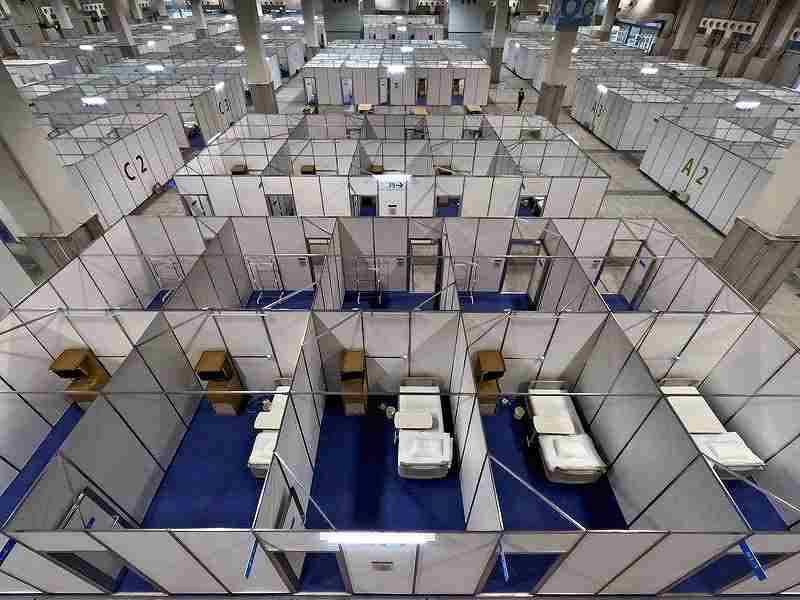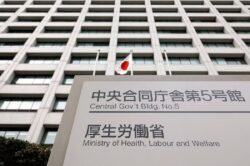Dedicated COVID-19 treatment facilities eyed in Japan to prepare for possible virus surge

Beds are seen at a large COVID-19 treatment center in Suminoe Ward, Osaka, on Nov. 5.
November 13, 2021
Efforts are accelerating in urban areas to develop dedicated COVID-19 treatment facilities so that patients will be able to receive swift care in the event of a resurgence of coronavirus infections.
Since Sept. 30, Tokyo Joto Hospital in Koto Ward, Tokyo, has been operating as a COVID-19 treatment facility with 50 beds for coronavirus patients with mild or moderate symptoms. The hospital used to have the capacity to treat 117 inpatients, but now only admits coronavirus patients. However, its general care department still offers outpatient services.
The hospital is run by the Japan Community Health Care Organization (JCHO). Shigeru Omi, head of the JCHO and chairman of the government panel of experts on the coronavirus, instructed the hospital to operate as a dedicated facility in late August.
At the time, the hospital had about 90 inpatients with cardiac or liver diseases and fractures, among other conditions. It reportedly took about a month to transfer or discharge all the inpatients.
To operate a dedicated COVID-19 hospital, it is necessary to install ventilators, implement appropriate infection prevention measures and secure enough staff.
In the case of Tokyo Joto Hospital, doctors have been dispatched from a neighboring university hospital among other facilities and nurses have been dispatched from such organizations as the Japanese Red Cross Society.
However, with COVID-19 cases on the decline, the daily number of inpatients at the hospital has never exceeded five. The hospital had no inpatients as of Friday.
“I wonder if it is such a good idea to limit general medical care and leave beds unoccupied for a long time. On the other hand, we have no choice because we have to be able to respond swiftly if infections spread again,” said Atsushi Chuma, head of the hospital. “I would like to gain as much experience as possible in treating coronavirus patients.”
Other Tokyo hospitals effectively operating as dedicated COVID-19 treatment facilities include Tokyo Metropolitan Hiroo Hospital, as well as Toshima Hospital and the Ebara Hospital, which are run by the Tokyo Metropolitan Health and Hospitals Corporation.
Meanwhile, Osaka City Juso Hospital has also been turned into a dedicated COVID-19 facility with 70 beds. The Osaka prefectural government has also created a temporary medical facility with 1000 beds at the Intex Osaka exhibition center.
Many coronavirus patients recuperating at home died during the fourth wave of the pandemic in spring, prompting a response from Osaka Gov. Hirofumi Yoshimura, who in late August said he wanted to reduce the risk of people dying at home.
By the end of October, 800 beds for people with no or mild symptoms and 200 beds for patients with moderate symptoms had been installed at the facility.
The beds are in 12-square-meter booths, and those for patients with moderate symptoms are equipped with oxygen masks. Patients will also be able to receive an antibody treatment aimed at preventing severe symptoms. Mattresses and pillows from the Tokyo 2020 athletes’ village are being used as bedding at the facility, which is equipped with washing machines and shower rooms.
Construction and operation costs of the privately operated facility total about ¥8.4 billion. Up to 43 doctors and 174 nurses have been secured to staff the treatment center, which will remain open until the end of May next year.
However, no patients have been treated at the facility yet.
The Osaka prefectural government plans to use the center if cases exceed the capacity of hospitals and recuperation facilities in the event of a disaster-level crisis caused by a resurgence of coronavirus infections.
Preparations to operate the center will begin when the occupancy of designated recuperation facilities reaches 50%, regarding the beds for mild patients, while preparations to utilize the beds for moderate patients will begin when hospital occupancy hits 70%.
“It would be best if there was no need to use these beds. But I would like them to be available in the event of an emergency,” Yoshimura said.
"Society" POPULAR ARTICLE
-

M4.9 Earthquake Hits Tokyo, Neighboring Prefectures
-

M7.5 Earthquake Hits Northern Japan; Tsunami Waves Observed in Hokkaido, Aomori and Iwate Prefectures
-

Tsukiji Market Urges Tourists to Avoid Visiting in Year-End
-

Israeli Tourists Refused Accommodation at Hotel in Japan’s Nagano Pref., Prompting Protest by Israeli Embassy and Probe by Prefecture
-

M5.7 Earthquake Hits Japan’s Kumamoto Pref., Measuring Upper 5 Intensity, No Tsunami Expected
JN ACCESS RANKING
-

Keidanren Chairman Yoshinobu Tsutsui Visits Kashiwazaki-Kariwa Nuclear Power Plant; Inspects New Emergency Safety System
-

Imports of Rare Earths from China Facing Delays, May Be Caused by Deterioration of Japan-China Relations
-

University of Tokyo Professor Discusses Japanese Economic Security in Interview Ahead of Forum
-

Japan Pulls out of Vietnam Nuclear Project, Complicating Hanoi’s Power Plans
-

Govt Aims to Expand NISA Program Lineup, Abolish Age Restriction























